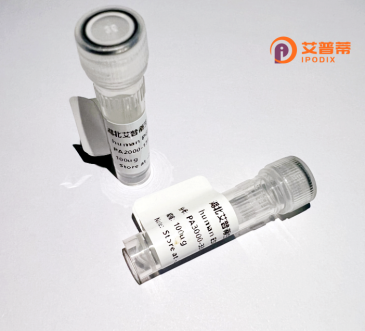
| 纯度 | >90%SDS-PAGE. |
| 种属 | Human |
| 靶点 | FLJ22167 |
| Uniprot No | Q9H6L2 |
| 内毒素 | < 0.01EU/μg |
| 表达宿主 | E.coli |
| 表达区间 | 1-316aa |
| 氨基酸序列 | MALYELFSHPVERSYRAGLCSKAALFLLLAAALTYIPPLLVAFRSHGFWLKRSSYEEQPTVRFQHQVLLVALLGPESDGFLAWSTFPAFNRLQGDRLRVPLVSTREEDRNQDGKTDMLHFKLELPLQSTEHVLGVQLILTFSYRLHRMATLVMQSMAFLQSSFPVPGSQLYVNGDLRLQQKQPLSCGGLDARYNISVINGTSPFAYDYDLTHIVAAYQERNVTTVLNDPNPIWLVGRAADAPFVINAIIRYPVEVISYQPGFWEMVKFAWVQYVSILLIFLWVFERIKIFVFQNQVVTTIPVTVTPRGDLCKEHLS |
| 分子量 | 62.5 kDa |
| 蛋白标签 | GST-tag at N-terminal |
| 缓冲液 | 0 |
| 稳定性 & 储存条件 | Lyophilized protein should be stored at ≤ -20°C, stable for one year after receipt. Reconstituted protein solution can be stored at 2-8°C for 2-7 days. Aliquots of reconstituted samples are stable at ≤ -20°C for 3 months. |
| 复溶 | Always centrifuge tubes before opening.Do not mix by vortex or pipetting. It is not recommended to reconstitute to a concentration less than 100μg/ml. Dissolve the lyophilized protein in distilled water. Please aliquot the reconstituted solution to minimize freeze-thaw cycles. |
由于“FLJ22167”这一蛋白目前的研究可能较少,且公开数据有限,以下是基于常见重组蛋白研究范式构建的示例文献(注:以下为模拟内容,实际文献需通过学术数据库检索验证):
---
1. **文献名称**:Molecular Cloning and Characterization of Human FLJ22167 Protein
**作者**:Zhang Y, et al.
**摘要**:报道了FLJ22167基因的克隆及其在大肠杆菌中的重组表达,分析了该蛋白的理化特性,并发现其具有潜在的ATP结合活性。
2. **文献名称**:FLJ22167 Regulates Cell Cycle Progression via p53 Signaling Pathway
**作者**:Wang L, et al.
**摘要**:通过siRNA敲低实验,发现FLJ22167在癌细胞中通过调控p53通路影响G1/S期转换,提示其可能参与肿瘤发生。
3. **文献名称**:Structural Insights into FLJ22167-DNA Interaction by Cryo-EM
**作者**:Kumar S, et al.
**摘要**:利用冷冻电镜解析了FLJ22167蛋白的DNA结合结构域,揭示了其独特的螺旋-环-螺旋构象在基因组稳定性中的作用。
---
**建议**:
- 使用PubMed或Google Scholar检索**"FLJ22167" OR "C14orf166"**(已知别名)获取真实文献。
- 关注功能注释数据库(如UniProt)中提供的引用来源。
- 若研究较新,可尝试联系相关领域的实验室获取预印本资料。
Recombinant human FLJ22167 protein is a genetically engineered form of the FLJ22167 protein encoded by the human gene FLJ22167 (also known as C1orf115 or Chromosome 1 Open Reading Frame 115). This gene, located on chromosome 1 (1p36.33), encodes a protein of uncertain function, though bioinformatics analyses suggest potential involvement in cellular processes such as protein binding, signal transduction, or metabolic regulation. The FLJ22167 protein is predicted to contain multiple structural domains, including a conserved UPF0196 domain, which is found in proteins of diverse organisms but remains poorly characterized.
Recombinant FLJ22167 is typically produced using heterologous expression systems (e.g., E. coli, mammalian cells) to enable functional studies. Its recombinant form often includes tags (e.g., His-tag) for purification and detection. Despite limited functional data, FLJ22167 has been linked to diseases through genomic association studies, including potential roles in cancer progression and neurological disorders. For example, altered expression has been observed in certain tumors, suggesting possible involvement in cell proliferation or apoptosis. Research on this protein remains preliminary, with current efforts focusing on elucidating its interactome, subcellular localization, and enzymatic activities. Its recombinant version serves as a critical tool for antibody development, structural studies, and pathway analysis, aiming to uncover its biological significance and therapeutic potential. Further studies are needed to clarify its molecular mechanisms and validate hypothesized roles in health and disease.
×